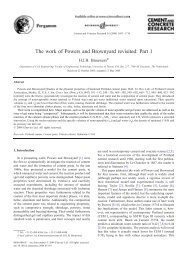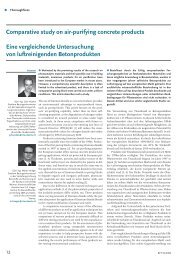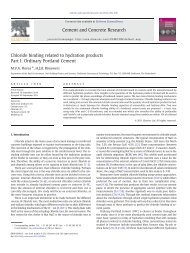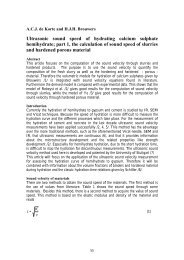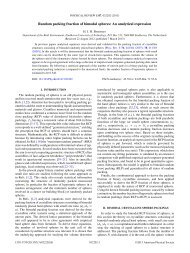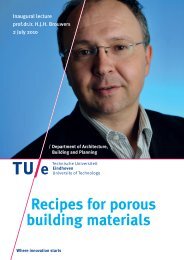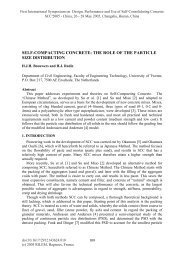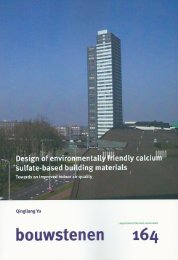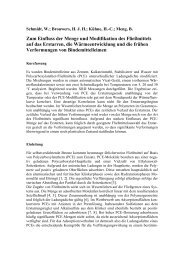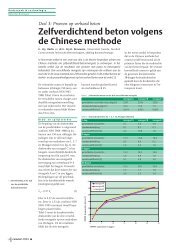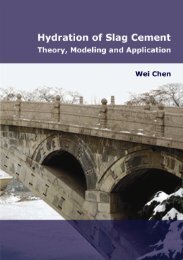RCM: A new model accounting for the non-linear ... - Jos Brouwers
RCM: A new model accounting for the non-linear ... - Jos Brouwers
RCM: A new model accounting for the non-linear ... - Jos Brouwers
You also want an ePaper? Increase the reach of your titles
YUMPU automatically turns print PDFs into web optimized ePapers that Google loves.
294 P. Spiesz et al. / Construction and Building Materials 27 (2012) 293–304<br />
Nomenclatures<br />
a migration constant (a = zFE/RT) (1/m)<br />
c concentration of chlorides in pore solution<br />
c b<br />
ðg Cl =dm 3<br />
solution Þ<br />
concentration of bound-chlorides ðg Cl =dm 3<br />
solution Þ<br />
cd concentration of chlorides at which 0.1 N AgNO3<br />
changes colour ðgCl =dm 3<br />
solutionÞ cs concentration of chlorides in liquid at liquid–solid interface<br />
ðgCl =dm 3<br />
solutionÞ ct total concentration of chlorides ðgCl =dm 3<br />
solutionÞ c0 concentration of chlorides in bulk solution<br />
ðgCl =dm 3<br />
solutionÞ Cb concentration of bound-chlorides (gCl /gsolid)<br />
Cbi initial concentration of bound-chlorides (gCl /gsolid)<br />
Ct total concentration of chlorides (gCl /gconcrete)<br />
Dapp apparent chloride diffusion coefficient (m 2 /s)<br />
Deff effective chloride diffusion coefficient (m 2 /s)<br />
Df chloride diffusion coefficient in free liquid (m 2 /s)<br />
D<strong>RCM</strong> chloride diffusion coefficient obtained from <strong>the</strong> <strong>RCM</strong><br />
test (Eq. (11)) (m 2 /s)<br />
D chloride diffusion coefficient (m 2 /s)<br />
D0 chloride diffusion coefficient in pore solution of concrete<br />
(m 2 /s)<br />
E electrical field (V/m)<br />
F Faraday constant (C/mol)<br />
i position in time (-)<br />
I imaginary number (–)<br />
j position in concrete (-)<br />
J total flux of chlorides (g s 1 m 2 )<br />
JM flux of chlorides due to migration (g s 1 m 2 )<br />
JD flux of chlorides due to diffusion (g s 1 m 2 )<br />
Jx total flux of chlorides in x direction (g s 1 m 2 )<br />
J0 total flux of chlorides through a unit area of solution<br />
(g s 1 m 2 ) or zero-order Bessel function of <strong>the</strong> first<br />
kind (–)<br />
k chloride mass transfer coefficient (1/s)<br />
Kb<br />
Kd chloride binding capacity (dm 3n /g n )<br />
gravimetric chloride distribution coefficient between liquid<br />
and solid (dm 3 /g)<br />
L thickness of concrete specimen (m)<br />
treated carefully. Thus, <strong>the</strong> objective of this study is to propose an<br />
improved chloride transport <strong>model</strong> in concrete <strong>for</strong> <strong>the</strong> <strong>non</strong>-steadystate<br />
migration test. This <strong>new</strong> <strong>model</strong>, modified with <strong>the</strong> assumptions<br />
of <strong>the</strong> <strong>non</strong>-<strong>linear</strong> chloride binding iso<strong>the</strong>rm and <strong>non</strong>-equilibrium<br />
conditions between chloride concentrations in <strong>the</strong> pore<br />
solution and in <strong>the</strong> solid phase, should be self-consistent and predict<br />
<strong>the</strong> transport of chloride in concrete better.<br />
2. The Rapid Chloride Migration test (NT Build 492 [2])<br />
2.1. Experimental procedure of <strong>the</strong> <strong>RCM</strong> test<br />
The <strong>RCM</strong> test is a <strong>non</strong>-steady-state test, based on <strong>the</strong> ionic migration<br />
induced by an external voltage applied across a concrete specimen<br />
saturated with Ca(OH)2-saturated water solution. The schematic and<br />
actual test set-ups are presented in Fig. 1. Due to <strong>the</strong> potential difference<br />
applied between <strong>the</strong> electrodes, chloride ions move from <strong>the</strong> upstream<br />
solution ( 2mol/dm 3 NaCl solution, hence <strong>the</strong> chloride<br />
concentration in <strong>the</strong> upstream solution is 70.9 g/dm 3 ), through <strong>the</strong><br />
concrete specimen, towards <strong>the</strong> downstream solution (NaOH –<br />
0.3 mol/dm 3 ). The duration of <strong>the</strong> test yields between 6 and 96 h<br />
(depending on <strong>the</strong> quality of <strong>the</strong> concrete expressed in terms of <strong>the</strong> ini-<br />
n chloride binding intensity parameter (–)<br />
r reaction term (1/s g/dm 3 )<br />
R universal gas constant (J mol 1 K 1 )<br />
t time (s)<br />
tM large finite number (s)<br />
t<strong>RCM</strong> duration of <strong>the</strong> <strong>RCM</strong> test (s)<br />
T temperature (K)<br />
u chloride migration velocity (u = zFUDeff/RTL) (m/s)<br />
U voltage (V)<br />
w/c water/cement ratio (–)<br />
x distance (m)<br />
xd chloride penetration depth indicated by AgNO3 (m)<br />
xf inflection point <strong>for</strong> <strong>the</strong> <strong>the</strong>oretical chloride concentration<br />
profile (m)<br />
X dimensionless representative of chloride concentration<br />
in pore solution (–)<br />
Y dimensionless representative of bound-chlorides concentration<br />
(–)<br />
z ion valence (–)<br />
Greek<br />
/ electrical potential (V)<br />
a laboratory constant <strong>for</strong> <strong>the</strong> <strong>RCM</strong> test (–)<br />
v trans<strong>for</strong>med distance (m)<br />
d constrictivity of pore structure (–)<br />
dc compressive strength (MPa)<br />
Dt interval of time (s)<br />
Dx interval of distance (m)<br />
u total water accessible porosity of concrete (–)<br />
k tortuosity of pore structure (–)<br />
C trans<strong>for</strong>med time (s)<br />
qc density of liquid-saturated concrete (g/dm 3 )<br />
qs density of solid state in concrete (g/dm 3 )<br />
s dimensionless representative of time (–)<br />
n dimensionless representative of chloride penetration<br />
front (–)<br />
Special symbols<br />
< > average<br />
tial current value when <strong>the</strong> external voltage is set to 30 V). Afterwards,<br />
<strong>the</strong> specimen is split and sprayed with AgNO3 – a colourimetric indicator<br />
<strong>for</strong> chlorides. Finally, <strong>the</strong> chloride penetration depth is measured<br />
and based on this value <strong>the</strong> D<strong>RCM</strong> is calculated from <strong>the</strong> ma<strong>the</strong>matical<br />
<strong>for</strong>mulas presented in <strong>the</strong> next Section of this paper.<br />
2.2. Current <strong>the</strong>oretical <strong>model</strong> of <strong>the</strong> <strong>RCM</strong> test<br />
The general continuity equation <strong>for</strong> <strong>the</strong> chloride transport in<br />
concrete presents as follows [11]:<br />
@ct<br />
þ urc þ r:J ¼ r ð1Þ<br />
@t<br />
where ct is <strong>the</strong> total chloride concentration in concrete, u <strong>the</strong> velocity<br />
of chloride ion, c <strong>the</strong> concentration of chlorides in pore solution<br />
of concrete, J <strong>the</strong> total flux of chlorides and r is <strong>the</strong> reaction term.<br />
As mentioned be<strong>for</strong>e, <strong>the</strong> chloride ions in migration experiments<br />
are accelerated by <strong>the</strong> electrical field in order to penetrate<br />
<strong>the</strong> saturated concrete specimen with a much higher rate in comparison<br />
to diffusion due to a concentration gradient. The total flux<br />
of chlorides <strong>for</strong> a combined process of diffusion and migration of<br />
ions through saturated and uncharged porous medium is given<br />
by <strong>the</strong> Nernst–Planck equation [1,5,6]:



